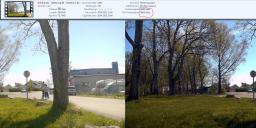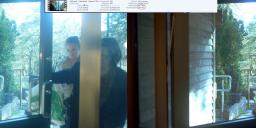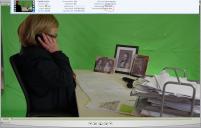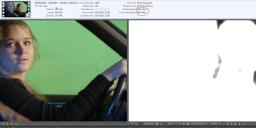
-
Well I found the problem. I always eject my camera mounted storage prior to disconnecting the USB cable from the computer, however I found that you MUST remove the USB cable from the camera regardless of whether or not it is connected to anything - otherwise the hack will not load.
This issue did not arise with my GH1, but certainly the GH2. Thank you Vitaliy and pundit for the suggestions. The good news - my GH2 has the patched firmware and the results are outstanding as expected.
-
First, check that battery is fully charged.
Second, check that your SD is not empty (have at least one photo made).
Third, if this did not help, use higher increment. 10 will do.
-
New GH2 body will not recognize hacked firmware?
I am sorry if this issue comes up often, but I have exhausted my searches through past posts and cannot find a solution. As a former owner of a GH1 that I have installed several hacks, I am frustrated with my new GH2 (came preloaded with ver. 1.1 factory firmware). It simply will not recognize a hacked firmware loaded on any of my cards. I am using the latest version of ptool, saving my file as GH2_V12.bin in the root of an in-camera formatted card. Nothing works.
I did read in the FAQ that perhaps I need to do with the version increment number, however I am reluctant to do that since the latest version of ptool says "1" should be selected, I am not sure if I should alter that field?
Thanks for any help!
-
Something I found confusing at first, which beginners might care to learn, are the letter assignments that Panasonic give to the different bit rates:
Format name Bit rate
PS 28 Mbps (1080p 50/60)
PH 21 Mbps (VBR)
HA 17 Mbps (VBR)
HF 13 Mbps (CBR)
HG 13 Mbps (VBR)
HN 9 Mbps (VBR)
HE 6 Mbps (VBR)
-
@docz you can try my gop2 for 720p pal.
http://personal-view.com/talks/discussion/comment/62658#Comment_62658 -
I've used 95mb Sandisk Extreme on the GH1, it's no more stable than any other card. It's not the cards, it's the hardware. The 100mb max lat is pretty much the highest it can go, but I have changed the Max Lat's stock GOP to 4 and it was decently stable. But that's at 1080x24p.
GOP2 at 50i is surprisingly stable and you MIGHT get a better overall bitrate if you do 1080x50i and convert it to 50p you'd probably get close to 720 resolution. Check my purple filter thread, the user Aki is doing a 50i at GOP2 hack that he likes and says provided superior resolution to even 1080p, but the hastle of 50i to 25p to 24p is too much for me, but it might work for you since you're in PAL country.
-
@docz Cool. Have you tried a faster SD card for the GOP1 patches, though I know getting GOP1 at 50p or even 50i is extremely difficult. I don't know of any settings that do that successfully/reliably, but hope someone will correct me and recommend one if I'm wrong. Pretty sure there are good GOP3 and GOP6 settings for those framerates though, lowering the GOP will help you a lot. Could just be a slow or flaky SD card.
-
Thanks for your suggestions guys. The reason I am using 50p is because I need it for slow-mo. I know that keying is not a "one-click" operation, to me it looks like the best footage to key on these cameras is the MJPEG >50mbit stuff. That office scene is a lot easier to key then the car scene - even though the car scene is in a well lit studio, and the office scene is just a sheet hung in my living room. But 30p->25p and slow-mo on some shots is just a nightmare - I haven't found any good workflows for that without a lot of transcoding, audio-sync issues, motion artifacts and so on. Target medium is 720p25 for this particular project. The car scenes that are locked off I will use that technique that Stray talked about isolating a background plate. But for the other scenes with camera movement, I will try to figure something else out. I was just hoping to get a little more IQ in the greenscreen footage, I feel that just a tiny boost in encoding bitrate would give med a little more detail in the washed out areas. I was also wondering if I had done something wrong in the hacking process since the bitrates were so low. I did open the files in StreamParser, and it to reports the same bitrates that windows does.
WB is set to 5300K for all lit scenes, since that is the whitepoint of my lights. And for the outdoor scene with a blue tint I shifted the WB because that is shot to be Day-for-Night. I found that giving the WB a blue tint helps even out the contrast and retain a bit more information once I crush it in post to make it look like night - that works really well.
I haven't found any GOP1 setting that will record for more than one second on my cameras. Lowest I can go (but I may be doing something wrong...) is GOP 12
-
"If you put a purple filter in front of the lens, you trick the camera into adding more color information into the weaker red and blue channels and could give you more bitrate. Once you remove the purple in post, even the greens look awesome."
But this doesn't actually work. The filter approach is not doing that (believe me I'd like it too, but the evidence isn't there and my god I've tested it enough), it isn't improving the quality of the red or blue channels. Plus you aren't going to remove the filters cast in post fully/accurately anyway. At best it just removes a bit of noise. @CRFilms Did you try that LUT I created for your filter to remove it from footage ? I'd be interested to know how bad a job it does with outdoor footage (badly I reckon).
Green screen I reckon its best to use a GOP 1 setting and shoot 24p, as thats the closest your going to get to a high bitrate that will be close to CBR. Then convert to what you need, mind you it is doable I reckon with a 50p setting if you're willing to put the work in. You'll not get a perfect key though (even with 24p), its hard to get a truly perfect key even in a studio environment with a great camera. I think its worth saying this cos I get the impression some people think that pulling keys is easy with perfect conditions. Expect to have to use multiple keys, combining them into your single matte. Also expect to build your own despill matte, do a bit of channel maths, and have to crack out the roto tools too.
@docz With your shots you could improve the consistency of the green by taking a shot without the talent there. Then pull a key from both the shot with the actor, and the shot without them. Then invert both the mattes/alphas from the keys, and merge them together with a divide function (divide the empty plate by the shot with the talent in it). Then create a constant of a colour you sample from the green screen, merge that with the shot without the talent (by subtracting/minus it from the constant). Then multiply that result by the matte/alpha you've got from the divide based merge. Then add/plus that to your original shot with the talent there, and this should create a shot with a constant green screen (no artifacts/colour shifts) which you can then pull a better key from. Yeah, sounds more painful than it is, but YMMV. Breaking it down like this though you can use various other correction tools within the process. It means you can clamp more out of the inital keys to solve some, if not all, of the artifact problems.
Edit: Ha, er obviously this is only going to work with a locked off shot as in the camera doesn't move, your plate without the actors has to be taken from the same position too. Oddly, I assumed they were both static camera shots, I dunno why.
-
@docz why 50p? Is the whole thing 720? You should really go for 1080p or at least MJPEG to probably get a better key. But if you're trying to go 50p then that would be problematic.
One thing you could try is setting GOP lower and upping the bitrate a bit. Rigs 1080p GOP1 hack is too unstable for me, but if you change it to GOP4, it becomes very stable and can shoot at peaks higher than 100mb max latitude hack. For 720by50 try GOP5 and see if it records.
You might also try the purple filter theory. If you put a purple filter in front of the lens, you trick the camera into adding more color information into the weaker red and blue channels and could give you more bitrate. Once you remove the purple in post, even the greens look awesome.
Also, what WB are you shooting at. I feel the lower settings 4k or less give less digital noise and could also give you a cleaner image.
-
Get StreamParser and use it to see actual bitrate.
-
Hey can I use a complete manual setting in ptools?
-
From the different scenes I have shot with this hack, the most I have gotten out of it was a landscape scene, with a lot of windy leaves. This scene I got 19mbit. Also I added a grab from a 1080p25 scene that also got 19mbit. Both of these scenes I experienced freezes and crashes, and they took a lot of takes to get down. It seems that once the encoder pushes 20mbit both my cameras start to get unstable. But as you can see in the last example the MJPEG mode has no problem giving me high bitrates. I would use that if I could get by with 30p - but I cannot.

 lowbitrate.jpg2580 x 720 - 648K
lowbitrate.jpg2580 x 720 - 648K
 lowerbitrate.jpg3855 x 1080 - 900K
lowerbitrate.jpg3855 x 1080 - 900K
 mjpeghigh.jpg1552 x 989 - 311K
mjpeghigh.jpg1552 x 989 - 311K -
Different hack settings generate different bit rates under different conditions. Shooting in 720p on the GH1, you might not be able to force the bit rate any higher under conditions such as these where there isn't a lot of detail in the scene. Test your camera on a detailed scene to be sure the hack worked and is generating high bit rates. GH2 hacks on a GH2 might get you more.
-
Hello, I am having some trouble with hacking my cameras. It seems even though the hack is successful, the encoder still chooses to encode the video at a really low bitrate - which introduces artifacts. I have posted this question before, but I was directed to post it here with example.
The video looks fine, but as soon as I try to key out the green ( or do other stuff like grading, color correction ++) I see some horrid artifacts. Upon investigating I found that the bitrate for the video was only 9mbit - not the 75mbit that I hacked it with. This clip used the 75mbit peak reliability patch. It is filmed in 720p50 AVCHD. I used standard film mode -2,-2, 0,-2. The card used was a 16GB Sandisk Extreme HD Video Class 10 30MB/S. It is shot on a GH1.
As you can see in the picture, the key I get from the screen shows how awful the artifacts are. In this example I need the semi transparent key to preserve the reflection on the window. I used the same technique described by Andrew Kramer on his car tutorial on videocopilot.net. He used a Canon 5d and did not experience this kind of artifacts.
I hacked the camera using the procedures described in the documentation provided on this site. The procedure seems to have been done successfully. I also checked the footage in streamparser software and it to reports the low bitrate.
Any help would be appreciated.

 greenscreen-low-bitrate.jpg2580 x 720 - 262K
greenscreen-low-bitrate.jpg2580 x 720 - 262K -
@filmsource just read the manual, your "problems" are so basic, first things first, en that is read TFM!!
And then after you understand the GH2, you may thinking off hacking your GH2........ -
hello im having a problem with the |GH2 Setup guide| im attaching this video so someone can see what im having a problem on.
-
Bressonftw, each of the different encoder settings will yield different bit rates in different modes under different conditions. I cannot generalize, but here is a bit of math to help you: divide 143 by the bit rate in Mbps. That gives you minutes per gigabyte. Multiply that by 4 to know how many minutes you'll get before spanning. Or multiply it by the card's capacity (e.g. 30 for a nominally 32-GB card) to know how many minutes the card will hold.
-
for some reason when i put my camera in c3, c2 or c1 i can change the appature like when its in M movie mode like in the 2nd video also my mic only works sometimes
-
I think this had been answered about 100 times. Load firmware in PTool and do not touch anything (I mean patches), save firmware to other file. Load in camera. Period.
Howdy, Stranger!
It looks like you're new here. If you want to get involved, click one of these buttons!
Categories
- Topics List23,993
- Blog5,725
- General and News1,354
- Hacks and Patches1,153
- ↳ Top Settings33
- ↳ Beginners256
- ↳ Archives402
- ↳ Hacks News and Development56
- Cameras2,368
- ↳ Panasonic995
- ↳ Canon118
- ↳ Sony156
- ↳ Nikon96
- ↳ Pentax and Samsung70
- ↳ Olympus and Fujifilm102
- ↳ Compacts and Camcorders300
- ↳ Smartphones for video97
- ↳ Pro Video Cameras191
- ↳ BlackMagic and other raw cameras116
- Skill1,960
- ↳ Business and distribution66
- ↳ Preparation, scripts and legal38
- ↳ Art149
- ↳ Import, Convert, Exporting291
- ↳ Editors191
- ↳ Effects and stunts115
- ↳ Color grading197
- ↳ Sound and Music280
- ↳ Lighting96
- ↳ Software and storage tips266
- Gear5,420
- ↳ Filters, Adapters, Matte boxes344
- ↳ Lenses1,582
- ↳ Follow focus and gears93
- ↳ Sound499
- ↳ Lighting gear314
- ↳ Camera movement230
- ↳ Gimbals and copters302
- ↳ Rigs and related stuff273
- ↳ Power solutions83
- ↳ Monitors and viewfinders340
- ↳ Tripods and fluid heads139
- ↳ Storage286
- ↳ Computers and studio gear560
- ↳ VR and 3D248
- Showcase1,859
- Marketplace2,834
- Offtopic1,320









